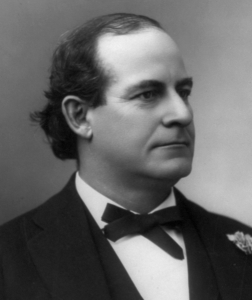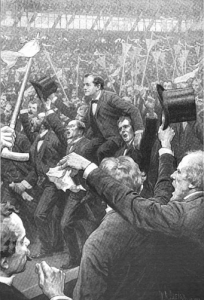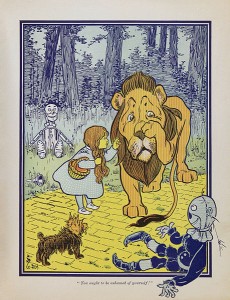Last week I wrote about The Wonderful Wizard of Oz by L. Frank Baum in its incarnations as a popular children’s book, the 1939 movie that has become a holiday favorite, and the story’s latest incarnation as the musical Wicked. (Here.) What more is there to say about Dorothy’s adventures in Oz?
It turns out The Wonderful Wizard of Oz can also been seen as a political allegory affecting the American presidential election of 1896. To set the stage, I need to review the political and economic situation in 1890s America. Don’t like history? Scroll down to Dorothy’s Allegory.
“As a Precious Metal, Silver is also Money.”
— Robert Kiyosaki
During the 1880s and 90s, the United States underwent massive social, political and economic change. Industrialization and large business conglomerates changed the face of American production from small businesses to immense enterprises employing a growing working class. Workers began to organize unions, a violent process pitting the working man against the forces of law and order.
In the West, silver mines produced so well the cost of extracting the ore exceeded the sale price. Farmers were also in dire straights due to overproduction and could not make enough from their crops to pay their debts. The farmers believed that if the United States went off the gold standard and allowed more silver money to circulate, prices for their goods would rise, plus they would be able to pay their debts with cheaper dollars. The silver industry thought this was a brilliant idea.
FREE SILVER
Responsive to pressure, Congress passed the Sherman Silver Repurchase Act in 1890. This dandy piece of legislation required the government to purchase 4.5 million ounces of silver every month. The United States became the second largest purchaser of silver in the world. To facilitate the new purchasing requirements the Treasury issued special notes that could be redeemed for either silver or gold. Gold was a better investment. Investors redeemed the notes for gold dollar coins. By 1891, the price of silver fell to 69 cents per ounce. And, instead of assisting farmers, the Repurchase Act actually contributed to a deflationary economy that resulted in the Panic of 1893 – a large economic depression.
In August 1893 Congress repealed the Sherman Silver Repurchase Act. The economy remained bad. People, particularly farmers, blamed Congress for their continued problems. A third political party called the Populists based their entire platform on the issue of “free silver.” They wanted silver to be accepted as legal tender for all debts public and private. In 1896 the U.S. Mint stopped producing silver coins.
“The humblest citizen of all the land, when clad in the armor of a righteous cause, is stronger than all the hosts of error.”
— William Jennings Bryan

Eighteen ninety-six was a presidential election year. Republicans nominated William McKinley. As the party of business, Republicans supported the gold standard. To recruit “free silver” voters, the party platform stated Republicans would support the gold standard only until an international agreement made bimetallism the norm. Thus spoke the party of Reason and Order.
On July 9, 1896 William Jennings Bryan mounted the podium of the Democratic Convention. A great orator and former congressman, Bryan wanted the presidential nomination. He was thirty-six years old.
Speaking on the issue of “free silver,” Bryan acknowledged the Republican stance, and found it without merit. “We care not upon what lines the battle is fought. If they say bimetallism is good but we cannot have it till some nation helps us, we reply that, instead of having a gold standard because England has, we shall restore bimetallism, and then let England have bimetallism because the United States have.”

Bryan’s conclusion electrified the convention: “Having behind us the commercial interests and the laboring interests and all the toiling masses, we shall answer their demands for a gold standard by saying to them, you shall not press down upon the brow of labor this crown of thorns.
You shall not crucify mankind upon a cross of gold.”
The convention broke into pandemonium. Some people, “like demented things, divested themselves of their coats and flung them high in the air.”
DOROTHY’S ALLEGORY

Writers are never isolated from current events, and many historians and economists have suggested that Baum’s book about Dorothy’s adventures in Oz was really an allegory about good and evil as played out in the campaign for free silver.
Plucky Dorothy represents America – honest, kind, and innocent. Paradoxically, Oz stands for the America of Big Business and Bankers. The cyclone of the Free Silver Movement swirls Dorothy away from the simplicity of Kansas to a land where an ounce of gold rules supreme. [Oz is also the abbreviation for ounce – oz.]
Dorothy’s house lands on the Wicked Witch of the East, killing her instantly. This witch stands for the business and financial interests of the Eastern American establishment. The house smashes the witch and Free Silver crushes Big Business. Dorothy’s silver shoes are the bimetallic standard.
Dorothy embarks on the yellow brick road (gold) to the Emerald City (Washington D.C.). On the way she encounters the Scarecrow who thinks he has no brains but is actually quite shrewd. Representing the virtuous farmer, the Scarecrow knows who’s who and what’s what.
The Tin Man is the American worker. The Wicked Witch of the East cursed him so he kept cutting off body parts with his ax. The tinsmith replaced them, and the man worked just as hard as before. Now entirely tin, he has no heart.
Last week I asked why is it only the Lion who has a prefix in front of his name. He’s always Cowardly Lion. Turns out, the Lion is William Jennings Bryan. In 1896, Bryan was a man of courage. But after losing the election, he became a political coward downplaying free silver in favor of other issues.
The Wizard is President McKinley’s advisor Marcus Alonzo Hanna. Representing the establishment perspective, the Wizard informs Dorothy and her friends
“In this country everyone must pay for everything he gets.”
REALLY?
Well, maybe he does, and maybe he doesn’t. This journey down allegory lane doesn’t change my conclusion about the moral of the story. We all at some level feel excluded. We wish a wizard would solve our problems: be it Bryan for free silver or McKinley for a sound economy. Eventually everyone has to face his or her fear alone, a situation that usually requires hard work.
Many thanks to David Hammes, economist extraordinaire, who brought Hugh Rockoff’s article about Oz as an economic allegory to my attention. Dr. Hammes bears no responsibility for my interpretation.
Acknowledgements:
Featured Image: Cartoon of William Jennings Bryan and the Cross of Gold by Grant Hamilton. 1896. U.S. Public Domain. Wikimedia Commons.
History Matters here
Hugh Rockoff. “The ‘Wizard of Oz’ as a Monetary Allegory. The Journal of Political Economy. Vol. 98, No. 4 (Aug., 1990), 739-760.

Sandra Wagner-Wright holds the doctoral degree in history and taught women’s and global history at the University of Hawai`i. Sandra travels for her research, most recently to Salem, Massachusetts, the setting of her new Salem Stories series. She also enjoys traveling for new experiences. Recent trips include Antarctica and a river cruise on the Rhine from Amsterdam to Basel.
Sandra particularly likes writing about strong women who make a difference. She lives in Hilo, Hawai`i with her family and writes a blog relating to history, travel, and the idiosyncrasies of life.


Iluminating and educational! Love it!
ox
Sandra, thanks for giving this your time and bringing it to readers’ attention in your, as always, lively way. It’s this sort of stuff that I used to bring in to classes.
I think most students still thought economics was, if not boring, then close to it.
I wonder if there’s any economics and history hidden in ‘The Wind in the Willows’?
Best,
David
Economics boring? Never! It’s all about the delivery, and yours is pretty darn good.
Interesting analogy representing history well. Will be digging more into Hugh Rockoff\’s article too. Thank you for the insight!!!